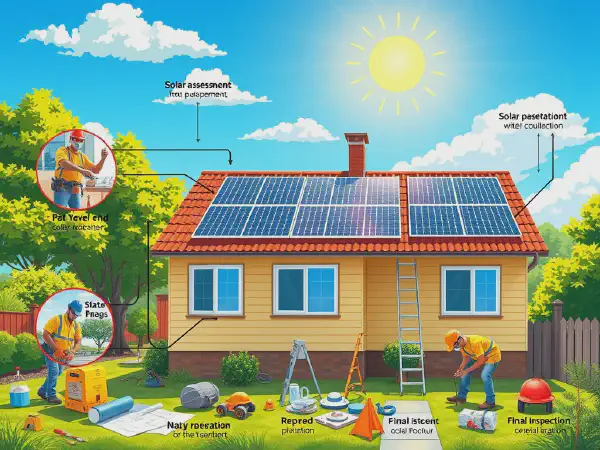The Complete Guide to Solar Panel Installation Processes

A Comprehensive Guide to Solar Panel Installation
Solar Panel Installation is an essential step towards harnessing renewable energy and reducing electricity costs. Through the installation of solar panels, individuals and businesses can generate their own electricity from sunlight, leading to significant long-term savings and a smaller carbon footprint.
In recent years, Solar Panel Installation has gained popularity due to its numerous benefits. From decreasing reliance on fossil fuels to increasing property value, solar panels provide a sustainable energy solution that supports both environmental goals and economic stability. This article dives into every aspect of solar panel installation to help you make informed decisions.
Understanding Solar Panel Installation involves several components, including knowledge about different types of solar panels, the installation process, maintenance requirements, and financial considerations. Each factor plays a crucial role in ensuring that your solar energy system operates efficiently and delivers maximum benefits.
Investing in Solar Panel Installation can significantly reduce energy bills and minimize your carbon footprint.
Whether you're preparing to install solar panels on your home or commercial property, it is important to approach the process systematically. This comprehensive guide will cover everything from the initial assessment to final installation and maintenance, giving you a clear roadmap to follow.
Ultimately, Solar Panel Installation can transform your energy consumption, making it cleaner and more efficient. By understanding the process and undertaking proper planning, you're well on your way to enjoying the advantages of solar energy.
Understanding Solar Panels
There are primarily three types of solar panels: Monocrystalline, Polycrystalline, and Thin-Film. Monocrystalline panels are known for their high efficiency and longevity but come at a premium price. Polycrystalline panels are more affordable but slightly less efficient. Thin-film panels, while lightweight and flexible, generally have the lowest efficiency rates. When choosing, consider factors like efficiency, space available for installation, and budget.
Solar panels convert sunlight into electricity through the photovoltaic (PV) effect. The panels are made up of solar cells that absorb photons from the sun, releasing electrons. This flow of electrons generates direct current (DC) electricity, which is then converted to alternating current (AC) electricity through an inverter, making it usable for home or business electrical systems.
When selecting solar panels, consider factors such as efficiency ratings, warranties, and the manufacturer’s reputation. It is also essential to evaluate the intended location for installation, local climate conditions, and potential shading from nearby structures or trees that may affect performance.
Preparing for Installation
A site assessment is crucial for Solar Panel Installation. This involves evaluating the area where panels will be installed to determine optimal placement, shading issues, and structural integrity. Proper assessment ensures that the solar system will function effectively and meet energy generation goals.
Before installation, it is important to understand the permits and regulations that pertain to solar energy systems in your area. Different localities have varying requirements, including building permits, zoning regulations, and connection agreements with utility companies. Complying with local codes is vital for a successful installation.
Choosing the right installer can significantly impact the performance and reliability of your solar power system. Look for certified professionals with experience in solar panel installations. Check their credentials, reviews, and previous projects to ensure they have a solid reputation in the industry.
Installation Process Steps
The first step in the installation process involves mounting the solar panels, which can be done on rooftops or on the ground. The mounting system must be securely installed to withstand environmental conditions while allowing for optimal solar exposure throughout the day.
Wiring and connecting the solar panels involves linking them together and to the inverter and electrical system of your home or business. Proper wiring is essential to ensure the system operates safely and effectively, minimizing energy loss.
Testing and commissioning the solar installation is the final step. This involves checking the entire system to ensure everything is functioning correctly. An installer should demonstrate how to monitor system performance and troubleshoot any potential issues after installation.
Maintenance and Care
Regular maintenance is crucial for the optimal performance of solar panels. It involves checking for dirt, debris, and any shading that may hinder efficiency. Periodic inspections can identify issues early, preventing costly repairs or system failures.
Common solar panel issues include decreased efficiency, disconnections, or damage from extreme weather. If you encounter problems, it is advisable to contact a professional for troubleshooting and repairs instead of attempting to fix them yourself.
Cleaning solar panels is essential for maintaining efficiency. Dust, snow, and bird droppings can block sunlight absorption. Use a soft brush or sponge with mild soapy water to clean the surface. Manual cleaning or hiring professionals is recommended, particularly for large installations.
Financial Considerations
Cost breakdown for solar panel installation includes equipment purchase, labor fees, permits, and miscellaneous expenses like mounting systems or inverters. Pricing can vary widely based on system size and location, making obtaining multiple quotes important for budget planning.
Various financing options exist for solar energy systems, such as cash purchases, solar loans, leasing agreements, or power purchase agreements (PPAs). These options allow homeowners to choose a payment method that fits their financial situation and goals for solar energy generation.
Many governments offer incentives and rebates for solar panel installations, including tax credits, grants, and net metering programs. Research local, state, and federal incentives to maximize savings and support your investment in solar energy.
